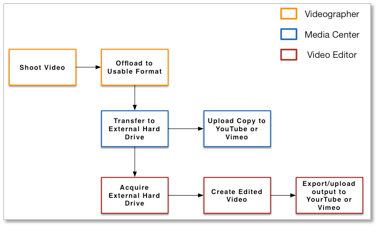Stories Home Viewed As A System Time Line Why Archive Lexicon
Why Archive Videos?
Who is this Guide for?
- Individual documenters, small or volunteer groups (e.g. study group), or collectives.
- You are creating or collecting digital video to document Dr. Deming’s theories, teachings, or life.
- You want to make sure the video documentation you created or collected can be used for advocacy, education, or historical memory – not just for now but into the future….
- You are not sure where to begin or are stuck on a particular problem
Why Archive?
With everything else you need to think about and do - why archive?
Ask yourself:
- Do you want your videos to be available in the future?
- Do you want your videos to raise awareness and educate future generations?
If the answer is yes, it is important to begin thinking about archiving before it is too late.
Still not sure? Here is what might happen if you do not take steps to archive:
- Videos may be accidentally or deliberately deleted and lost forever.
- Videos may exist somewhere, but no one can find them.
- Someone may find your videos, but no one can understand what they are about.
- Videos cannot be sufficiently authenticated.
- Videos’ quality may become so degraded that no one can use them.
- Videos may be in a format that eventually no one can play.
What is Archiving?
- Archiving is… a general term for the range of practices and decisions that support the long-term preservation, use, and accessibility of content with enduring value.
- Archiving is … an ongoing process that begins when a video is created and continues infinitely into the future.
- Archiving is…a process that can be incorporated into your existing video workflows.
- Archiving is … a way to ensure your videos remain authentic and intact.
- Archiving is … a way to ensure your videos are available, findable and playable long into the future.
- Archiving is NOT… a one-time action.
- Archiving is NOT… putting your videos on a hard drive and leaving it on a shelf.
A SCENARIO
A Media Center
The Media Center has an efficient workflow for getting videos online in a timely manner, but has not given much thought to the videos’ long-term usability up to now.

An efficient workflow for getting videos online, but not for long-term usability.
As more and more videos are collected, the Media Center starts to see the potential value of the collection to future research and promotional purposes, and as a historical record of events. However, the way they have organized their videos is not consistent, and only one person really knows how to find the older videos. They also realize that media outlets are having a hard time verifying their videos, and that it would be hard for the Media Center to prove that its videos are authentic. Then, one day, someone accidentally drops a cup of coffee onto one of the hard drives and it immediately stops working. Because the Media Center does not have a backup copy, the videos on that drive are permanently lost.
In an effort to improve their practices, the Media Center adds some archive-minded steps to their workflow:
- The Videographer notes important metadata for each video, such as date, location, hash value and her name, in a document that she includes with her videos on the encrypted USB stick.
- After receiving and decrypting the USB stick, the Media Center offloads the original files to its primary storage.
- The Media Center organizes the videos and makes backup copies on 2 additional hard drives.
- The Media Center makes a catalog record for each video in a database, expanding on the metadata provided by the videographer, to make the videos findable.
- The Media Center adds detailed titles and descriptions to its YouTube videos, and provides descriptions along with videos to news outlets.
- Instead of transcoding videos during offload, the Video Editor makes transcoded copies from the offloaded original files.
- The Video Editor outputs a full quality master of her edited video in addition to the lower quality output she uploads to YouTube.
A few steps are added to the video workflow to improve the long-term usability of the videos.

